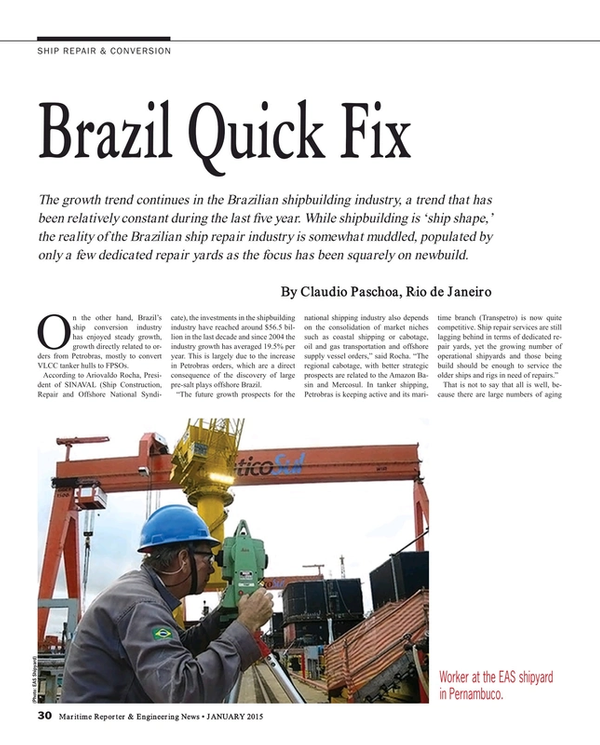
Shipbuilding, Repair and Conversion: Brazil's Quick Fix
The growth trend continues in the Brazilian shipbuilding industry, a trend that has been relatively constant during the last five year. While shipbuilding is ‘ship shape,’ the reality of the Brazilian ship repair industry is somewhat muddled, populated by only a few dedicated repair yards as the focus has been squarely on newbuild.
On the other hand, Brazil’s ship conversion industry has enjoyed steady growth, growth directly related to orders from Petrobras, mostly to convert VLCC tanker hulls to FPSOs.
According to Ariovaldo Rocha, President of SINAVAL (Ship Construction, Repair and Offshore National Syndicate), the investments in the shipbuilding industry have reached around $56.5 billion in the last decade and since 2004 the industry growth has averaged 19.5% per year. This is largely due to the increase in Petrobras orders, which are a direct consequence of the discovery of large pre-salt plays offshore Brazil.
“The future growth prospects for the national shipping industry also depends on the consolidation of market niches such as coastal shipping or cabotage, oil and gas transportation and offshore supply vessel orders,” said Rocha. “The regional cabotage, with better strategic prospects are related to the Amazon Basin and Mercosul. In tanker shipping, Petrobras is keeping active and its maritime branch (Transpetro) is now quite competitive. Ship repair services are still lagging behind in terms of dedicated repair yards, yet the growing number of operational shipyards and those being build should be enough to service the older ships and rigs in need of repairs.”
That is not to say that all is well, because there are large numbers of aging rigs in the Campos and Espírito Santo Basins and also along the Northeast coast, some of which, according to Sindipetro (Offshore Workers Syndicate) are in dire conditions and their repair has only recently become a priority for the national operator. According to Brazilian Government reports and the Brazilian Work Ministry (Ministério Público do Trabalho), Petrobras has between seven and 10 rigs in need of repairs, which may force them to stop production and tow them to repair yards soon.
Ship Repair
The Merchant Navy Fund (FMM), managed by the Ministry of Transport, said that 357 vessels and five shipyard construction or expansion projects, have been completed since 2007. But not only rigs and large ships need repairs. The large and growing fleet of OSVs sailing in Brazil also demand repair berths.
In terms of OSVs, PROREFAM, which is a Petrobras OSV construction program has 87 vessels ordered, of these 26 are in operation and 61 under construction. The fleet in operation in Brazil according to ABEAM (Brazilian Association of Offshore Support Companies) number 450 vessels, of which 211 are registered in Brazil and 239 registered abroad. ABEAM also forecast that expansions until 2020 will add 236 more vessels, and of this total of 686 vessels, 300 will be registered in Brazil and 386 registered abroad. These number show what can be easily seen in some shipyards in Rio de Janeiro, such as Mauá Shipyard, Aliança Shipyard, Renave and Inhaúma Shipyard, where there are nearly always some OSVs being repaired.
The table on the next page shows clearly that there is only one large shipyard dedicated to ship repair and although all the other yards listed are capable of repair jobs, their berths are primarily aimed at attracting full construction jobs.
“With the large number of ships, rigs, FPSOs, drillships and OSVs being built in Brazil, along with the large number local and foreign vessels operational in our waters, there is a need for more shipyards dedicated to ship repair. Presently only the RENAVE yard in Rio fits this category and this may eventually cause delays in repairs that may eventually affect oil and gas production,” said Rocha. Even though Petrobras has a pair of repair rigs, which perform some repairs to production rigs offshore, major repairs may still need to be done ashore.
The greatest fear now is of a bottleneck in ship and rig repairs, if the majority of the existing shipyard berths are occupied by new construction. This problem will only increase as more ships and rigs become operational and building efforts continue at the level they are without more dedicated repair yards being built. It is possible that Petrobras itself may opt to build or lease at least one more shipyard to work exclusively on needed repairs, yet there is no firm position from the national operator at this time.
Ship Conversion
There are a five or six shipyards working on ship conversions in Brazil. Most of these are converting VLCC hulls into FPSOs, as well as manufacturing and installing topsides and auxiliary equipment. However, there are also some yards working on converting existing production and drilling rigs in order to increase production through the installation of new equipment or to enhance drilling capabilities at deepwater pre-salt plays, such as Petrobras’ recent demand for drilling rigs to install MPD systems.
There are four VLCC hull being converted to FPSOs at the Inhaúma shipyard in Rio de Janeiro and another eight “replicant” FPSOs being built at the Rio Grande shipyard in the southern state of Rio Grande do Sul. Brasa shipyard in Rio de Janeiro has recently completed the conversion of the Cidade de Ilhabela FPSO, which is already linked to the Sapinhoá pre-salt field at the Santos Basin. Brasa shipyard is already building modules for two more FPSOs, although the hulls to be converted have not yet arrived.
In 2013, the P-55 semi-submersible rig had its hull conversion done at the EAS yard in Pernambuco, while the topsides were integrated at the QGI yard in Rio Grande do Sul. During the same year another five hulls had their topsides integrated at QGI, BrasFels, Quip and EAS shipyards, while in 2014, two FPSO hulls were converted and topsides integrated at Brasa shipyard and BrasFels, (FPSO Cidade de Mangaratiba), both of which are in Rio de Janeiro.
“There will be more than 15 new platforms necessary by 2020, other than the 16 in construction in Brazil at the moment. Until 2030, the demand is forecasted at 41 more platforms. A new format will be necessary for the collaboration between local and international shipyards in order to supply this large demand,” said Rocha.
With these hull conversions and topside integration jobs being done in Brazilian shipyards, local content ceases to be a problem for the shipyards since more than 95% of their workforce is local.
Although there have been a few delays in these conversion and integration projects, Rocha believes that delays will diminish with increased experience of the yards and their workers. If the number of FPSOs needed for production at the larger pre-salt plays stands strong, it is a virtual guarantee that orders for hull conversions and topside fabrication will continue.
The Libra pre-salt field for example, is expected to need at least 12 FPSOs for its 1,500 sq. km and an unspecified number of wells, which some Petrobras executives believe may be more than 90 wells, including production and injection wells. That is not considering other large finds such as Franco and Carcará, which are also massive, with the latter potentially being bigger than Libra, as its 470 meter thick reservoir is almost 50% bigger than Libra’s.
All these figures serve to show the importance to local shipyards of dominating the techniques and procedures used to convert VLCC hulls into FPSOs and seamlessly fabricate and integrate the topsides in the least amount of time possible.
One of the greatest fears at Petrobras and within the higher spheres of the Brazilian government are delays in the FPSO deliveries, because these delays will directly affect the potential for increased pre-salt production, which is a key factor in reaching Petrobras’ goal of doubling Brazilian oil and gas production to 5.2 million barrel/day by 2020 and tripling the production by 2030.
“The work related to ship conversion and module integration is complex and highly technical, this large amount of conversion and integration projects will greatly increase the technical expertise and experience of the local workforce, consequently decreasing delivery times, while maintaining high quality and safety standards, permitting this sector of the shipbuilding industry to also become globally competitive.” said Rocha.
(As published in the January 2015 edition of Maritime Reporter & Engineering News - http://magazines.marinelink.com/Magazines/MaritimeReporter)
Read Shipbuilding, Repair and Conversion: Brazil's Quick Fix in Pdf, Flash or Html5 edition of January 2015 Maritime Reporter
Other stories from January 2015 issue
Content
- Editorial: BWTS. Like it or Not, Here it Comes page: 6
- Marine Casualties & Fast Ferry Follies page: 8
- Bayonne Drydock Logs Successful '14 page: 10
- N-KOM Sees Increased Tanker Business page: 10
- Limitless Salvage page: 12
- What Keeps ‘Good Ship’ RINA Buoyant page: 20
- Dynamic Positioning & the Potential for USCG Regulations page: 24
- Chemical Tanker Turned OSV page: 26
- Shipbuilding, Repair and Conversion: Brazil's Quick Fix page: 30
- The Ballast Water Management Conundrum page: 34
- The Art of Propeller Making page: 44
- Lindner Sees Strong 2015 page: 48
- Beyond the Black Box page: 50
- BICERA Explosion Relief Valve page: 53
- Transas: The Bridge to Tomorrow page: 54
- Volvo Penta Debuts New Marine Engines page: 56
- VapCor Introduces Lindemann Marine Products page: 56
- New YANMAR EPA Tier III Engine page: 56
- New Gasket from Victaulic page: 56
- Clean Seal Molded Specialties Launched page: 56
- Dometic Debuts New Product Line page: 56
- First Container for LNG Hybrid Barge page: 56
- Wärtsilä to Power LNG-fueled RoPax Ferry page: 56
- Kidde Fire Systems: Multi-Language ARIES NETLink page: 56
- Next Generation Bridge Concept page: 57
- BCG Delivers Training Upgrades page: 58
- RescueME MOB1 page: 58
- New Stereo from ASA Electronics page: 58


